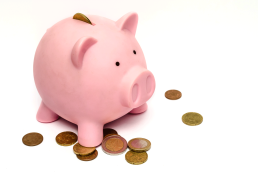Four Reasons to Stay Invested During the Coronavirus Volatility
These four charts may help you understand the current market volatility as a result of Covid-19 and what you should know as an investor. Remember that markets have seen downturns like this before and history shows dips are followed by recoveries.
A History of Epidemics and Global Equity Returns
History has shown that when pandemics happen, markets may see some economic downturn, but they also recover. This chart below shows how returns from global equities have been affected by 12 pandemics over the last 50 years. The conclusion: markets recovered and pandemics had little effect on the long-term return of stock markets.
MSCI World Net Total Return US$ Index

Source: Bloomberg, Fidelity International, February 2020.

Source: Bloomberg, Fidelity International, February 2020.
Don’t Miss Out on the Market’s Best Days
Since we can not time the market, it can be tempting to pull out your money from fear of potentially losing it all. What you don’t realize is that you put your portfolio at the potential risk of missing out on the market’s best day.
The chart below shows that a $10,000 investment can become $5,020 by missing out on 60 of the market’s best days.
Annualized returns in the S&P/TSX Composite Index

Source: Refinitiv. S&P/TSX Composite Index total returns from January 1, 1986, to December 31, 2019. Past performance is no guarantee of future results. It is not possible to invest directly in an index.
Time Reduces the Volatility of Returns
This chart shows a comparison of the highest and lowest returns for various investment time frames from December 1980 to December 2019. We see here that volatility has primarily been a short-term concern. Keeping at least part of our money invested in stock markets for longer than 5 years significantly reduces the chances of a negative return and increases the chances of substantial positive returns.

Sources: Refinitiv. Indexes used: Canadian equities, S&P/TSX Composite Index; U.S. equities, S&P 500 Index; global equities, MSCI World Index; Canadian bonds, FTSE Canada Universe Bond Index. Based on monthly total returns (CDN$), except S&P 500 Index. Past performance is no guarantee of future results. The index returns presented are calculated monthly total returns in CDN$ (includes reinvested dividends) from December 1980 to December 2019. The three-, five-, ten- and 20-year periods reflect annualized returns. It is not possible to invest directly in an index. Returns are in CDN$ and include reinvested dividends. As at December 31, 2019.
The Cycle to Success
Market volatility can cause lots of panic, especially one that is linked to a global tragedy like the coronavirus. Markets have been, are and always will be cyclical. Historically, markets that have gone down eventually recovered.
This chart is a simple way to look at how many investors feel during an economic downturn. When markets start to recover, those who stayed invested tend to feel relieved, because they may benefit from the market recovery.

What To Do Next?
Since you can’t time the market, the best thing to do is to talk to us about what is right for your portfolio. If you have concerns about the effect of the current downturn on your long-term plan that we have built together. Please give a financial advisor a call to discuss the best decisions to ensure that you live the life you have earned today and in the future.
We look forward to speaking with you soon.
Four Reasons to Stay Invested During the Coronavirus Volatility
These four charts may help you understand the current market volatility as a result of Covid-19 and what you should know as an investor. Remember that markets have seen downturns like this before and history shows dips are followed by recoveries.
A History of Epidemics and Global Equity Returns
History has shown that when pandemics happen, markets may see some economic downturn, but they also recover. This chart below shows how returns from global equities have been affected by 12 pandemics over the last 50 years. The conclusion: markets recovered and pandemics had little effect on the long-term return of stock markets.
MSCI World Net Total Return US$ Index

Source: Bloomberg, Fidelity International, February 2020.

Source: Bloomberg, Fidelity International, February 2020.
Don’t Miss Out on the Market’s Best Days
Since we can not time the market, it can be tempting to pull out your money from fear of potentially losing it all. What you don’t realize is that you put your portfolio at the potential risk of missing out on the market’s best day.
The chart below shows that a $10,000 investment can become $5,020 by missing out on 60 of the market’s best days.
Annualized returns in the S&P/TSX Composite Index

Source: Refinitiv. S&P/TSX Composite Index total returns from January 1, 1986, to December 31, 2019. Past performance is no guarantee of future results. It is not possible to invest directly in an index.
Time Reduces the Volatility of Returns
This chart shows a comparison of the highest and lowest returns for various investment time frames from December 1980 to December 2019. We see here that volatility has primarily been a short-term concern. Keeping at least part of our money invested in stock markets for longer than 5 years significantly reduces the chances of a negative return and increases the chances of substantial positive returns.

Sources: Refinitiv. Indexes used: Canadian equities, S&P/TSX Composite Index; U.S. equities, S&P 500 Index; global equities, MSCI World Index; Canadian bonds, FTSE Canada Universe Bond Index. Based on monthly total returns (CDN$), except S&P 500 Index. Past performance is no guarantee of future results. The index returns presented are calculated monthly total returns in CDN$ (includes reinvested dividends) from December 1980 to December 2019. The three-, five-, ten- and 20-year periods reflect annualized returns. It is not possible to invest directly in an index. Returns are in CDN$ and include reinvested dividends. As at December 31, 2019.
The Cycle to Success
Market volatility can cause lots of panic, especially one that is linked to a global tragedy like the coronavirus. Markets have been, are and always will be cyclical. Historically, markets that have gone down eventually recovered.
This chart is a simple way to look at how many investors feel during an economic downturn. When markets start to recover, those who stayed invested tend to feel relieved, because they may benefit from the market recovery.

What To Do Next?
Since you can’t time the market, the best thing to do is to talk to us about what is right for your portfolio. If you have concerns about the effect of the current downturn on your long-term plan that we have built together. Please give a financial advisor a call to discuss the best decisions to ensure that you live the life you have earned today and in the future.
We look forward to speaking with you soon.
What is the RRSP Homebuyer’s Plan?
Saving is a lifestyle habit that helps with the realization of milestones, like buying a new home. The Registered Retirement Savings Plan (RRSP) in Canada allows you to have an organized savings system with reduced tax, and comfortable deductions based on your personal interests. This plan can then be channeled towards different things like health, education, and in this case, housing.
RRSP has several programs that allow individuals to withdraw from their RRSP accounts to fund major expenditures like a new car, tuition or their first home. For new homeowners, the RRSP program has the following features.
Total deductible amount
Depending on how long you have been operating your RRSP account, you should know the age of maturity for funds that are accessible/ can be withdrawn. Usually, it must have been up to 90days of saving that specific amount before you can request to withdraw it. For the homebuyer plan, you can withdraw $35, 000 (Thirty-five thousand dollars) to fund your home purchase, while as a couple, you and your partner can withdraw a total of $70, 000 (Seventy thousand dollars) as full- or part- capital for your new home.
Verifiable agreement for home/land purchase
While processing the funds from your Registered Retirement Savings Plan account to deposit is an important part of the procedure, it is also important that you get a signed agreement before you can buy or build a home. The agreement must also indicate that the home you are buying/building meets the required standards. This validates you as befitting of the benefits of the homebuyers’ RRSP program.
No tax disadvantage
One of the best advantages of the RRSP is that there are no additional disadvantages when it comes to tax –as long as you remain on track with the repayment, and pay up within fifteen years. The best way to ensure this is by being careful not to use the funds from your RRSP as full-capital unless you have the earning power to pay back within the stipulated timeframe.
Fixed repayment schedule
To help you make your repayment stress free, you can set up a weekly, monthly or bi-monthly savings plan that will be your fixed schedule for paying back the withdrawn amount within the stipulated time. The payment schedule also helps you know your deficit so you can always plan your finances rightly.
Knowing the pros of using RRSP to fund your new home is great, but you should carefully think it through before getting started. How secured is your income? Will you be able to maintain the repayment? Is it worth losing all possible future benefits?
If you are certain of your choice then no need for further delay, contact your RRSP account manager today.
5 New Year's Resolution That Will Save You Money
The New Year is well underway and we are nearing the end of the first month. By now, several New Year’s resolutions have been forgotten, postponed or, if the individual is really keen, in the works toward completion. Most New Year’s resolutions are focused on generic things like losing weight, eating healthier and becoming more adventurous. While these are all good in their lanes, financial prudence should also be emphasized.
You can channel your energy for the New Year into resolutions that will help you save money. Saving is a lifestyle which, like most habits, can only be developed one step at a time. You can choose to start small, or invest a whopping amount, but whichever way you choose to explore, make it your New Year’s resolution to save money. To get you started, here are five New Year’s resolutions that will actually help you save money.
Become debt-free
One of the reasons why people struggle to save is the fact that they are constantly paying off debts. As a result, any income they get goes towards paying a debt or the other. Make it your New Year’s resolution to avoid debts as much as you can, and pay off all your debts as fast as you can. Otherwise, you’ll keep earning to pay, not to have.
Generate an extra source of income
The importance of having an additional source of income cannot be overemphasized. Human wants are unlimited, and as such, it is important to generate enough income to settle the most pressing wants. You can dip into a fast-moving business or start-up something new, just to earn a little extra on the side. That way, by the time your main income arrives, you won’t be restricted to that bracket of revenue.
Invest in your retirement
There is no such thing as ‘too young to save for retirement’. In fact, the earlier you start saving, the better your retirement plan. You can start a government-authorized Registered Retirement Savings Plan (RRSP) and put aside a portion of your monthly earnings, without paying tax, towards your retirement.
Build a budget
This year, live on a budget that allows you to have the basic needs and just a little extra. No need for extravagances. Build a budget to guide your lifestyle.
Start a rainy day savings
Save towards eventualities. It will ensure that you are not caught unprepared for any happenstance and give you a sense of financial security and confidence.
Don’t be scared by your savings target, just take it in little bits and with some discipline, you’ll definitely achieve your goal before the year ends.
5 New Year’s Resolutions That Will Save You Money
2019 is coming to an end and it is no surprise that plans are springing up from left, right and every corner. People are going on adventures, making amendments and readying for improvements. Positive personal, social and overall changes to the individual lifestyle of most people are definitely highlighted on the table of things to develop in the New Year. To make it a perfect list of resolutions, one key thing to put at the top of your to-do list for the New Year is to cultivate the habit of saving money. You can create a safety net for yourself, while exploring several opportunities, by saving money with these New Year’s resolutions!
Live by a budget
Having a budget is the best way to save money. You can start by making smarter decisions about what should be on and off the budget. Let the necessities be reflected and leave a little for contingencies. Living by a budget will help you reduce the incidence of unnecessary expenses and therefore, save more.
Quality first, always!
While it is truly enticing to buy more at a cheaper rate, in the New Year let your policy be to buy the best you can for the lowest you can. Not necessarily the largest number you can buy. One quality product that lasts long is better than a cheap product that requires constant changing. Save yourself the stress and expense of constant repair and replace it by going for quality items only.
Want or need?
This resolution should become a mantra as you go into the New Year. Before making a purchase of any sort, ask yourself 'is this product a want or a need'. Wants are in-the-moment urges that wear off if suppressed while needs, on the other hand, are essentials to your lifestyle. To save more, cater to your needs more than your wants!
Multiple streams of income
The best way to save more is to earn more. Make it a resolution to seek multiple streams of earning legitimate income in the New Year. Look for side gigs that won't infringe on your daily job and earn something extra that can help you save more -comfortably.
Invest in your retirement (RRSP)
Options like the Registered Retirement Savings Plan (RRSP) in Canada help you save up against retirement by providing options for profitable investments. By investing, you are not just saving, you are saving towards a defined goal!
A money-saving lifestyle doesn’t have to be an over-the-top level of frugal. You can make simple changes in your habits and preferences to give you more money to tuck away in case of a rainy day!
5 Reasons to Open an RRSP
Saving can be really difficult, and laden with temptations, but having a Registered Retirement Savings Plan (RRSP) is a sure-fire way to achieve your financial goals with ease. This is a method that keeps some part of your income in a private account, against retirement. Not sold? Here are five amazing benefits of opening an RRSP.
1. Dip for essential needs
RRSP makes adequate provision for your needs through plans that enable you to withdraw the needed capital as long as you pay it back in the stipulated time frame. One of these options is the Home Buyers’ plan that allows you to take as much as $25,000 from your savings plan, in order to make down payment for your intended home. There is also the Lifelong Learning Plan that allows you to take up to $20,000 for costs incurred during an academic pursuit by you or your spouse. This way, saving with RRSP does not hinder your needs, but rather supports you in achieving them.
2. Spousal consideration
You may have noticed the provision for your spouse in the first point above, but it gets even better! If your net income is a higher amount than what your spouse makes, you can support their retirement savings by creating a spousal RRSP. As opposed to bearing the weight of higher tax deduction, the retirement funds that you contribute will become split across the both of you and that automatically reduces your tax payment on each income. A spousal RRSP emphasizes the ‘better half’ reference to being a couple.
3. Growing savings
With RRSP, your savings are no longer money you simply keep for rainy days. It grows with tax-free investments that are promoted by the government, so your savings actually grows faster with earnings in your RRSP.
4. Post-retirement income
The whole point of an RRSP is saving towards retirement but instead of getting your money in divisible huge chunks, you can switch the plan to a Registered Retirement Income Fund (RRIF) after retirement. This way you get monthly payment, that is taxed based on your income bracket. So you still have a secured source of income that can aid your life plans.
5. Tax eduction
Saving only gets better when it balances your income. With your RRSP contributions, you get a deduction on the amount you pay for tax since the federal government calculates your savings split from your income before deriving your tax payment on that salary. The higher you earn, the lower your designated tax payment.
Creating an RRSP early is advisable because it just means a higher total of savings by the time you’ve hit retirement age –and you have the added option of progressing with an RRIF!
5 Money Saving Tricks for Students
An average student’s problems rotate around classes, friends, relationships and constantly running out of money. It gets more difficult when saving seems impossible. But it is, with the right tricks –five of which we have highlighted for you!
1. Budget
This should be the first thing you do when you get your allowance (or paycheck, if you work). Outline your priorities and plan according to the money you have, makings sure to include funds for emergencies and other contingencies. The trick to saving right is to be prepared for at least ninety percent of all your expenses and the best way to do that, is to have a budget. Creating a detailed budget is one thing, sticking to it is another. Discipline is all you need to spend wisely!
2. Lifestyle
Your lifestyle may just be the reason why you are spending so much and saving so little if any. Cutting down on the outings, eat-outs and expensive fun time can have a tremendous effect on your savings because you get to spend less. Naturally, by spending less of your income, you have enough to set aside for rainy days, or concrete expenses. It doesn’t mean you have to be the killjoy in your group of friends though, you just have to adapt your lifestyle choices to the best fit for your account balance so you don’t end up with a deficit simply because you wanted to remain a cool kid.
3. RRSP
If saving was ranked based on academic degrees then, a Registered Retirement Savings Plan (RRSP) is the PhD. of having a savings account. Registered by the federal government, the RRSP is an account that you contribute to on a schedule (usually, a monthly basis) and can only access completely when you retire. It is advisable to create an RRSP as early as your college days so that your retirement funds will be considerably higher. Also, having an RRSP gives you access to the Lifelong Learning Plan, an education fund.
4. Thrifting
Thrift shopping is the best and most effective way to curb your spending and save more. Stay off the limited edition racks and opt for sales and thrift items instead. You look cool and spend less doing so!
5. Recycling
One thing that takes up your money which you may not notice, is buying stuff that you could have recycled. Your pajamas top has a cut and you start looking to buy a new one when you have old tees that you aren’t wearing anywhere. Basically, you need to invest in a lot of DIY so you can shave off unnecessary expenses.
Saving helps you live smarter and worry less!
How Can I Get Money to Repair My House?
Repairing a house is crucial to keeping it functional and aesthetically appealing. It is essential to renovate a home to prevent it from falling into disrepair and lose its value. Several parts of a house need to be appropriately maintained, repaired or replaced such as a window replacement, door replacement, and basement waterproofing.
Although many homeowners turn a blind eye to house repair until they can no longer avoid it, the maintenance and repairs of a house should be on the priority list. If funding the repair of your home is your concern, read this write-up to the end to know the 5 ways you can get money to repair your house.
Aside from using your RRSP to get money to repair your house, here are 5 ways you can get money to repair your house:
1. Saving
When you need to repair your home, and you do not have the cash right now, you can choose to save up over time to have enough money to pay for the repairs outrightly. This is the best approach to repair your house without incurring any debts.
2. Credit Cards
You can make use of credit cards to pay for the essential repairs you have to carry out on your house knowing that you will pay off at each month-end. You can get a zero-interest card that does not require paying back until after six months or a year.
3. Personal Loan
Personal loans come with a lower interest rate than credit cards. Ask your bank for a personal loan that is payable after one year or as you deem fit. You can access quick cash to renovate your house and prevent your building from going into a bad shape.
4. Peer-to-Peer Borrowing
You can also look into borrowing money from colleagues, family members, or friends first repairing your house. This option does not usually attract interests, and it is a useful source of raising the money you need.
5. Personal Line of Credit
This is another way to get money to repair your house. It comes with a lower interest rate than the credit card. Besides, you pay interest only on the amount you use. You can also re-borrow funds without having to reapply all over again.
Must-Have Apps for Managing Your Finance
Successfully managing your finance can be one hell of a daunting task. This is probably not because you’re financially reckless or any other reason at all. A good number of people find adopting good financial management practices just as difficult, hence taking help from a financial advisor is a good idea.
We live in a highly digitalized era were we make transactions with the swipe of a card or click of a button. This makes it very easy to lose track of your spending or go way out of the budget without even knowing it. Everyone always has plans on saving better and sticking to their budget but I guess it never really happens. Effectively managing your money and keeping your finance in order isn’t the easiest thing to do after all.
Just as much as technology makes spending easy, it has also made provisions to help you save, budget and better manage your finance. The world is fast evolving and almost everything we do manually are getting automated by the minute. Technology has provided a wide range of mobile apps that will help you better manage your finance than any account manager ever will.
It’s time to say goodbye to ineffective budgets, manually tracking your expenses and constantly motoring your bank balance to know if you’re still within budget. These “finance management apps” are a must-have for every first-time iPhone owners who are looking to stay on top of their finance.
Whether you need to track the upcoming bill and pay on-the-go, a reminder when you’re almost eating up your budget or connect to your bank acct to get accurate details of your spending and even as much as keeping up with your credit score. These must-have finance management apps will make you a finance expert in no time. With these apps, you can easily….
- Get email reminders on the due dates for your various bills
- Track your subscription and make immediate renewal when due
- Manage your bank account and digital wallets from your mobile
- Create budgets and expenditures, set monthly financial limits…
Whatever your financial management challenges may be, we’ve sifted the internet and app store to help you compile a list of the best money management apps out there. These apps will help you keep up with your finance wherever and whenever.
Here are 4 must-have apps for managing your finance:
1. Mint
Mint gives you a complete overview of your expenditure and absolute control over your spending right from your mobile device. Aside from helping you create a sustainable budget, once you connect mint to your bank account, mint updates you one every purchase you make, tracks your spending and provides email alert when your bills are due.
Mint allows users to view their credit score whenever they want and it also provides users with tips on how to keep perfect credit score and maintain a healthy financial life. Managing your finance and making the best of your money definitely gets easier with mint.
2. YNAB
YNAB (You Need A Budget) not only guides you in building and sustaining better budget but also allows you to gain control of your finance. YNAB achieves this by helping users spend an allocated fraction of their last month’s income judiciously.
When you have the YNAB app, you don’t have to worry about the imbalanced budget. The app adjusts your budget categories whenever you overspend and also provide a detailed report of all your spending for the month. With the YNAB app, you become the master of your own finance.
3. Personal Capital
Personal investment managers are now losing their job due to this app. This awesome app combines the feature of helping you create a monthly budget that gives room for saving and help you manage your assets and investments. With affiliations to over 14,000 financial institutions, you can rest assured managing your account and tracking your spending is as easy as it gets with Personal Capital.
Personal Capital has a distinguishing feature that allows you grow your investment, better manage risk and discover opportunities for investment portfolio diversification through the apps in-built AI and provided registered advisors that offer investment advice tailored to meet your investment goals.
4. Prism
Prism provides the ultimate solution to bill payment. This helps you better manage your finance by providing notifications when your bills are due. Prism can also be automated to directly pay your bills several days before or on the due date. Prism will definitely help you properly manage your finance and also prevent late bill payments.
5 First-Time Home Buyer Tips
Are you a first-time homebuyer looking for tips to help you in buying your dream home? Do you want to know the right steps to take to get the best value for your money? Do not stress out; below are the perfect tips for first-time homebuyers.
-
Start Saving Early for a Downpayment
Immediately you have conceived the idea of buying a home, start saving for the mandatory 20% downpayment. Except you have the money to complete the buying process without borrowing; you must start saving early. As a first-time homebuyer, related mortgage programs require 3-5% downpayment, which can be huge depending on the cost of the house you intend to purchase. To avoid having trouble with cash, start saving early.
-
Assess Downpayments and Sources of Funding
Go through different sources of funding available to raise the money you need to pay for your new home. Each mortgage option comes with its pros and cons. If you need to raise fund through a mortgage, consider one of the following:
- Federal Housing Administration Loan - requires 3.5% downpayment
- Veterans Affairs Loan - requires no downpayment because the Department of Veterans Affairs secures it.
- Conventional Mortgage - requires as low as 3% downpayment.
If you have critical illness insurance, getting a preferred mortgage comes with some technicalities. Your lender may not require your critical illness cover because it will be added as a rider to a mortgage life insurance policy. However, the lender may request to be named as the beneficiary of the critical illness insurance as an assurance that they would recover some parts of the loan in case the recipient falls ill and cannot survive.
-
Get Pre-approved for a Loan
Having chosen from the available sources of raising the money you need to buy your dream home, make savings for the closing costs too. After that, contact the mortgage company you have decided to raise fund from. Get pre-approved for a loan and obtain a letter attesting to your pre-approval status. A pre-approval letter shows that you are indeed serious about purchasing a home.
-
Find a Home and Inspect It
The next step is to search for homes placed on sale that are within your price range. You need an agent to help you with the procedure. Go ahead with the negotiation with your agent and proceed to home inspection. Before making a purchase after and seal the deal.
-
Prepare for Closing
As a first-time homebuyer, you should plan for closing the homebuying deal. Quite a lot of people make the mistake of not preparing for this closing process. It may take 43 days to complete the deal. This stage requires a series of documents to be signed and exchanged. As a result, you need the services of a legal team to interpret the content of the documents and assure you that everything is documented correctly. Bear in mind that you would be responsible for the legal fees and other expenses at the closing of the homebuying.










